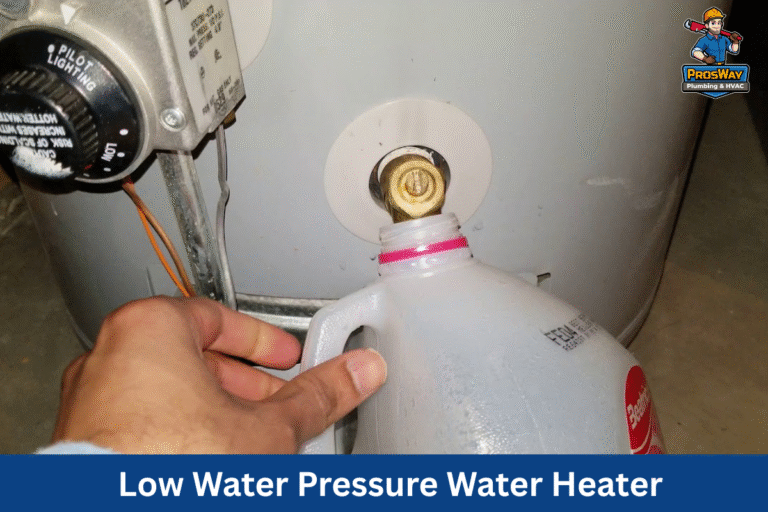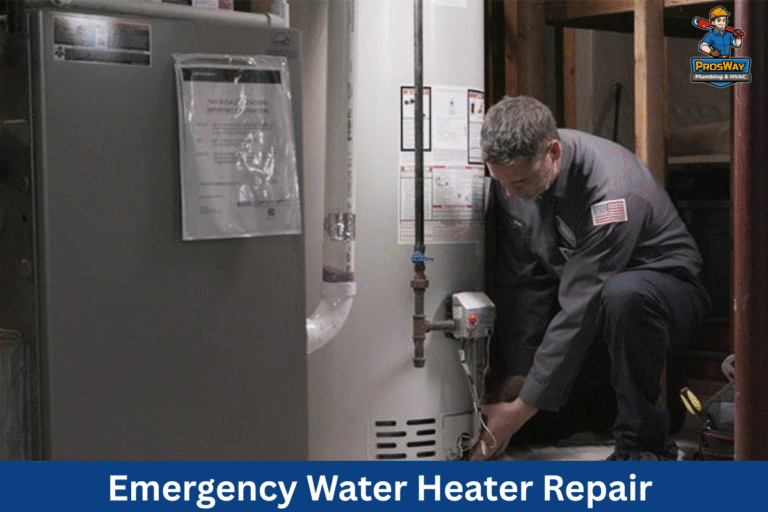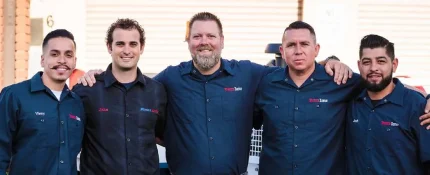Tree roots are a significant threat to underground plumbing—especially in older neighborhoods across Northern New Jersey. At ProsWay Plumbing & HVAC, we’ve seen how fast a small root intrusion can turn into a costly sewer line emergency.
That’s why it’s critical for homeowners to know how roots invade pipes, what signs to look for, and how to prevent damage. This guide explains how tree roots affect sewer systems and which tree species pose the most significant risks.
And the best way to stop roots before they become a problem. Whether you need prevention strategies or a root removal plan, ProsWay is here to help keep your system flowing smoothly.
Key Takeaways
- Tree roots invade sewer lines through cracks and joints in search of moisture.
- Slow drains, gurgling sounds, and foul odors are early signs of root intrusion.
- Trees like maple, oak, and poplar have aggressive roots that commonly damage pipes.
- Preventive steps include proper tree placement, root barriers, and regular inspections.
- Treatment options include hydrojetting, root cutting, chemical inhibitors, or pipe relining.
What Makes Tree Roots Target Sewer Lines?
Tree roots naturally seek water and nutrients, and sewer lines may offer an attractive source of both. In this section, we explain how tree roots compromise sewer lines by infiltrating them and what factors make certain pipe materials more vulnerable. For more information on the importance of maintaining sewer lines, check out regular sewer line checkups.
Why Tree Roots Seek Out Sewer Pipes?
Tree roots naturally follow moisture, and the leakage from an old, compromised pipe can create a moist microenvironment that attracts roots.
can create a moist microenvironment. Trees, particularly maple and oak, have aggressive root systems that can grow several feet horizontally.
Even roots of moderately sized trees can extend up to 100 feet from the trunk in search of water. When a sewer line leaks, it creates localized soil saturation, enticing roots to grow into the pipe.
Over time, the roots can completely block or even fracture the sewer system, resulting in severe backup issues that may require extensive repairs or a complete Sewer Line Replacement.
The Process of Root Infiltration Into Sewer Systems
The process typically begins when small cracks or old joints in the pipe allow moisture to seep out. As the soil around the pipe becomes saturated, tree roots sense the water and grow toward it. As they enter through the tiniest fissures, they expand and grow.
Over time, these roots thicken and cause considerable blockage, leading to reduced flow or even total system failure. In many cases, the damage isn’t immediately apparent until backups or gurgling sinks start occurring.
Which Pipes Are Most Vulnerable to Root Intrusion?
Older cast iron and clay pipes are particularly susceptible to root intrusions because they are brittle and develop cracks over time.
Newer PVC and concrete pipes tend to be more resistant. But they are not immune, even if joints and connections are weak. Regular inspections are essential to catch root-related damage early and minimize long-term issues between tree roots and sewer lines.
What Are the Early Signs of Tree Root Intrusion?
Recognizing the first signs of root interference is key to avoiding expensive repairs. Minor symptoms inside and outside the home can reveal hidden issues when tree roots and sewer lines conflict.
Early Indicators of Root Presence in Your Drains
The first signs of tree root interference often include slow drains and reduced outlet water flow. A buildup of wastewater without apparent blockages in everyday use is a strong indicator.
Subtle symptoms, such as occasional gurgling noises or minor backups, can also point to initial root penetration. Homeowners might notice that water from sinks or toilets drains more slowly than usual.
Gurgling Sounds and Slow Drains as Clues
Gurgling sounds from the drain or toilet typically suggest that air is trapped within partially blocked pipes. As tree roots intrude into the sewer line, they create obstructions that disrupt normal water flow.
This interference forces water and air to escape through weak spots, leading to audible gastric noises in your plumbing. If you hear such unexpected sounds, it is critical to have a sewer inspection conducted immediately.
Ignoring these symptoms can lead to larger problems, such as complete blockages and unsanitary conditions.
Where Can You Spot Root Damage Outside?
Sometimes, tree roots impacting your sewer line are visible outside the home. You may notice cracks in the pavement or a wet patch in your lawn, which could indicate underground seepage.
Additionally, if you observe unusually lush vegetation compared to the surrounding area, it might benefit from the extra moisture.
This external evidence is often a telltale sign that tree roots have extended into the sewer system, further emphasizing the need for a professional assessment.
Which Trees Pose the Greatest Threat to Sewer Lines?
Understanding which trees pose the highest risk is essential when planning your property’s landscaping and maintenance routine.
In this section, we assess the characteristics of trees most likely to interfere with sewer lines and discuss methods to evaluate the risk they pose to your infrastructure.
Tree Species With Aggressive Root Systems Near Pipes
Particular tree species, such as maple, oak, and poplar, are notorious for their aggressive roots. These trees tend to produce extensive networks of roots that can travel far and wide in search of moisture.
An arborist might note that these species are often responsible for a significant percentage of sewer repairs due to root intrusion.
Their roots proliferate and exert considerable pressure, making them formidable opponents to aging sewer lines. This allows you to monitor potential conflicts between tree roots and sewer lines over time.
Mapping Tree Root Zones Relative to Sewer Line Paths
Mapping your property to determine the proximity of trees to sewer lines is a smart step. By identifying the “root zones,” which typically extend as far as the tree’s canopy, you can assess how close these roots are to your main sewer line.
For instance, if trees are located within 10 feet of your pipes, the risk of intrusion is significantly higher. Tools like ground-penetrating radar or professional sewer line cameras can visually map the roots relative to the pipes.
Where Is It Safe to Plant Trees Around Sewer Lines?
Research suggests that a safe distance for planting trees near sewer lines is at least twice the mature canopy spread of the tree.
For example, if a tree is expected to have a 20-foot-wide canopy at maturity, it should ideally be planted at least 40 feet away from any known sewer lines. This precaution helps to reduce the likelihood of roots infiltrating the pipes over time.
Studies have shown that maintaining proper distances can reduce root intrusion incidents by up to 40%, which is significant considering the high cost of sewer repairs. Homeowners should consult with a certified arborist to determine the best planting locations.
Key Takeaways
- Aggressive tree species such as maple, oak, and poplar are high risk.
- Proper mapping of root zones helps evaluate danger zones.
- Maintaining safe planting distances significantly reduces risk.
- Landscaping practices and regular inspections are essential in managing tree root threats.
What Should You Do When Tree Roots Block Sewer Lines?

Once tree roots have infiltrated your sewer lines, immediate action is needed to restore proper flow and prevent further damage.
We discuss professional inspection methods, root removal techniques, repair options, and the considerations for tree removal when necessary.
Professional Inspection Methods for Root Problems
The first step in resolving tree root blockages is thoroughly inspecting the sewer line. Professionals widely use advanced methods like CCTV inspection to visualize the extent of root intrusion.
In Northern New Jersey, reputable companies such as ProsWay Plumbing & HVAC employ high-resolution cameras to assess the condition of pipes. This inspection identifies the blockage’s location and how severe the root penetration is.
Additionally, sonic or electromagnetic tests can determine pipe integrity and thickness, providing further insight into necessary repair strategies.
Techniques for Removing Tree Roots From Sewer Lines
Once the problem is identified, several techniques are available to remove tree roots. Mechanical root cutting is a standard solution.
Hydrojetting uses high-pressure water streams to clear blockages and wash away root fragments, while mechanical cutters physically remove larger root masses.
Chemical treatments, such as root growth inhibitors, can also be applied to deter regrowth. Each method has its benefits, and often, a combination of mechanical removal and chemical treatment is most effective.
Which Repair Options Work Best After Root Removal?
After root removal, repairs are crucial. Methods like pipe relining or traditional pipe replacement are standard solutions.
Pipe relining involves inserting a new liner inside the existing pipe, creating a new, root-proof barrier without extensive excavation. For more information, you can read about sewer line repair services.
This technique effectively preserves the existing infrastructure while ensuring long-term protection against root intrusion.
In cases where the sewer line has been severely compromised, complete pipe replacement may be necessary.
The choice between relining and replacement depends on the pipe’s condition, the extent of the damage, and the material involved.
What Strategies Prevent Tree Roots From Infiltrating Sewer Lines?
Prevention is the most brilliant move regarding tree roots and sewer lines. Implementing proactive strategies helps homeowners avoid expensive repairs and maintain smooth plumbing for years.
There are multiple ways to keep roots out of your pipes, from thoughtful landscaping choices to barrier systems and routine maintenance.
Selecting and Placing Trees to Protect Sewer Lines
A proactive approach to preventing root intrusion begins with careful tree selection and placement. When planning new landscaping, opt for tree species with less aggressive root systems or those known for shallow root growth.
This precaution minimizes the risk of roots reaching the pipes. Proper placement protects your infrastructure and enhances your property’s aesthetic appeal. Consulting with a certified arborist ensures you choose the right species for your climate and soil conditions.
Using Physical Root Barriers Effectively
Physical root barriers are among the most effective methods of preventing root intrusion. These barriers, typically made of high-density plastic or metal, create an impermeable zone between the growing root system and the sewer pipe.
They must be installed during construction or during landscaping renovations to be effective. Studies have shown that certain types of root barriers can reduce root penetration by up to 60%.
While they involve an initial investment, these barriers can extend the life of your sewer line by preventing future root damage, ultimately lowering maintenance and repair costs.
Why Is Routine Maintenance Important for Prevention?
Routine sewer maintenance plays a crucial role in preventing tree root invasion. Regular cleaning and inspections can detect early signs of root intrusion before they become major blockages.
Scheduled maintenance, often performed by companies like ProsWay Plumbing & HVAC, includes hydrojetting the pipes and applying root growth inhibitors. This preventive approach ensures the proper function of your sewer system.
Depending on the age and condition of their piping system, homeowners should schedule these inspections annually or biannually.
How Can You Manage Trees and Sewer Lines Long-Term?

Creating a long-term plan for the coexistence of trees and sewer lines is essential for sustainable property management. This forward-thinking approach involves regular maintenance, expert consultation.
Maintaining Healthy Trees While Safeguarding Pipes
Maintaining the health of your trees while protecting your sewer infrastructure calls for balanced practices. Regular pruning and root maintenance can help control the spread of overly aggressive roots.
Homeowners are encouraged to work with certified arborists to monitor the growth and health of their trees. Healthy trees are less likely to produce invasive roots than stressed trees searching for water under challenging conditions.
Implementing tree care programs that include proper watering, fertilization, and periodic inspections can promote a stable root system that coexists with the underground.
Homeowner Responsibilities for Sewer Line Integrity
Being proactive about your sewer line’s condition is essential as a homeowner. Regular inspections, prompt repair of leaks, and the use of preventive maintenance services help preserve the integrity of your sewer system.
Documenting any signs of problems and immediately contacting professionals for inspections can prevent minor issues from escalating into large-scale failures.
Education on properly maintaining trees and sewer lines will equip you to manage the risk effectively. Taking a proactive role in scheduling inspections can be the key to avoiding emergency repairs and preserving property values.
What Local Rules Should You Know About Tree Placement?
Municipal guidelines often dictate the proper placement and maintenance of trees near utility lines. Homeowners need to familiarize themselves with local regulations to ensure compliance.
For example, certain municipalities in Northern New Jersey may require trees to be planted away from the main sewer line or protective barriers to be installed.
Understanding these guidelines can help reduce the likelihood of disputes with local authorities and avoid potential fines. Moreover, staying informed about guideline changes and updates can assist in future-proofing your property.
Frequently Asked Questions
Is it necessary to remove trees if they are causing root problems in sewer lines?
Tree removal is typically a last resort. Often, installing root barriers or performing regular maintenance can address the sewer line problems. However, after consulting with professionals, removal may be considered if a tree’s roots are too aggressive and cause recurring damage.
How often should I inspect my sewer lines for root intrusion?
It is recommended to have your sewer lines inspected annually or biannually, especially if your home has older pipes or is near large, mature trees. Regular inspections enable early detection and timely intervention.
Can modern sewer pipes prevent root intrusion?
Modern sewer pipes made from materials like reinforced PVC or concrete are more resistant to root intrusion than older cast iron or clay pipes. However, they offer better protection but are not immune, making regular inspections and maintenance important.
Conclusion
Tree root intrusion poses a serious risk to sewer lines, especially in older systems prevalent in residential areas like Northern New Jersey. Recognizing early signs, assessing tree species and their proximity are crucial in protecting your sewer infrastructure. Addressing these issues early on can save homeowners significant time and money, whether through routine maintenance or preventative measures like physical root barriers. We encourage you to schedule regular inspections and consult with certified professionals to safeguard your home’s plumbing against invasive tree roots.
Need Help with Tree Roots in Your Sewer Line? Call ProsWay
Tree roots can quietly damage your sewer system—don’t wait for a costly emergency. ProsWay Plumbing & HVAC offers expert inspections, root removal, and long-term solutions to clear your lines. Call us now at (862) 260-5870 or Book Online to schedule your sewer line check-up and protect your home!









